Human Centric Lighting: Biodynamic Lighting Systems in Trend
LED technology and digital control of light have paved the way for a new dimension in lighting design. Human Centric Lighting, the trend theme in the lighting industry, focuses on "healthy" light and the effect of light on performance and well-being. Innovative lighting solutions are therefore increasingly taking into account people's biological lighting needs.
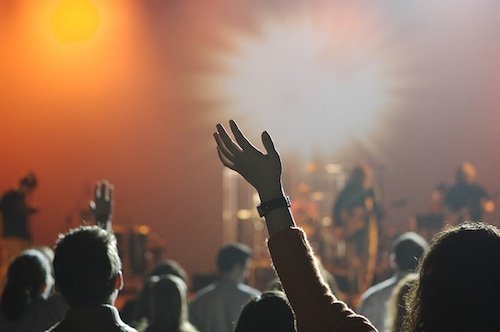
What is Human Centric Lighting?
Human Centric Lighting (HCL) is based on the discovery of a third receptor in the eye that controls the human biological clock. These light-sense cells of the human eye are not there to see, but control the production of melatonin. Like small organic antennas, they register the light and control its biological effect on the body. The so-called circadian rhythm, which is oriented towards daylight and regulates the waking and sleeping phases of the human being, is decisive here.
Human Centric Lighting is therefore about "circadian lighting", a lighting concept that imitates the natural course of daylight and is modeled on the biological rhythm of human beings. In order to achieve a biological or melanopical lighting effect, brightness, dynamics, gradient and light colour must be optimally matched.
For example, there are luminaires equipped with both warm white and cold white LEDs. In combination with white/white controls, this enables individual colour mixing. By changing the light intensity and light colour, the course of the day can be simulated. LED technology and digital control have made this lighting technology possible in the first place.
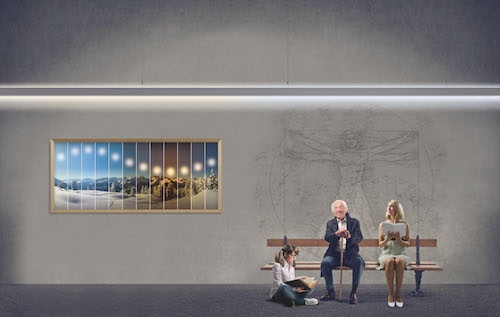
© The Austrian company planlicht creates innovative HCL lighting concepts
Areas of application of Human Centric Lighting
The possible fields of application for biodynamic lighting systems are diverse and range from private areas, industry and offices to hospitals and care facilities.
1. Industrial sector
People who work shifts suffer because of the irregular working hours often under the "shift-worker syndrome." In addition to this, older employees in the industrial sector a higher lighting requirement was detected. Through the use of biodynamic lighting management systems can be effectively counteracted here. to be. Employees in industry are more alert and more focused, they sleep better and are more rested during the day.
This is confirmed by an interdisciplinary study from Austria in which two biodynamic lighting scenarios for general lighting were tested. In both cases, illuminance was varied from 1,000 to biologically effective 2,000 lux. While the brightness changed clearly perceptibly in longer time intervals in the first test arrangement, in a second project non-perceptible brightness dynamics with short time intervals were tested for shift workers. Both studies came to the conclusion that dynamic light has a positive influence on the well-being of employees. You are more efficient at work and benefit from a better quality of sleep.
In industrial halls with window fronts or skylights, for example, artificial light can be flexibly controlled in addition to daylight. Biodynamic lighting solutions of this type require electronically controllable lighting systems that combine warm white light with daylight white. Alternatively, retrofitting with light sources of cooler colour temperatures from 6,500 Kelvin is also an option. 
© Age-appropriate biodynamic light system from Waldmann
2. Office
Studies also show here that employees feel more comfortable in offices with biologically effective lighting and are also more concentrated in their daily work. Performance and motivation increase demonstrably.
Conference rooms, canteens and rooms with low daylight supply such as open-plan offices are particularly suitable for biodynamic lighting concepts. Since the third photoreceptors are located in the lower part of the retina, the light in offices should be incident from above and from the front. This means that walls or ceilings should be illuminated over a wide area. For example, large-area luminaires equipped with daylight white and warm white fluorescent lamps and infinitely adjustable can be combined with individual HCL workplace lighting.
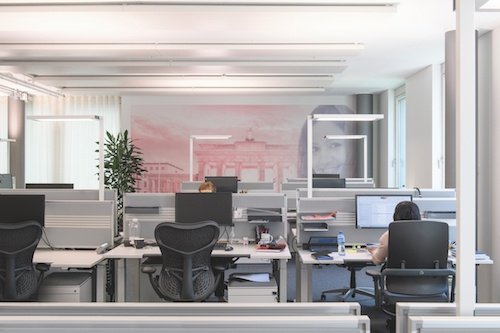
© Biodynamic lighting systems from Waldmann at Bayer Basel
A very nice example in the office sector is Bayer, which has equipped its headquarters in Basel with biodynamic lighting solutions. At the workplaces, free-standing luminaires in conjunction with the VTL (Visual Timing Light) lighting management system provide biodynamic lighting. The integrated daylight and presence sensors ensure that light is always available automatically when it is needed. The biodynamic luminaires are also used in meeting and video conference rooms, in communication areas and corridor zones as well as in the cafeteria.
3. Hospital and Nursing
In hospitals, retirement homes and nursing homes, patients and residents often suffer from a lack of daylight. People with dementia or other cognitive disorders are particularly sensitive to this.
Biologically effective light promotes recovery and makes treatments more efficient. The patient's circadian rhythm remains stable, which helps patients sleep better and reduces therapy times and the need for care, especially at night. As a positive side effect, this noticeably reduces the workload on hospital staff. The staff also benefits from less fatigue of their own.
Biodynamic lighting can be installed in patient rooms, as well as day rooms for caregivers, intensive care units and recovery rooms.
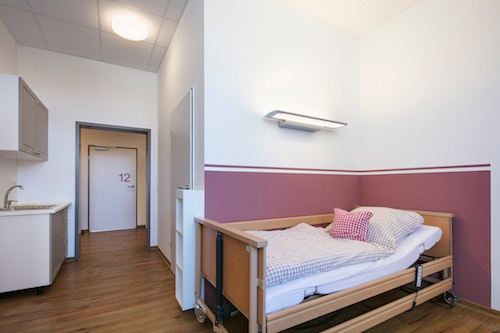
© Waldmann, patient room in the nursing therapy centre of pro-persona.care
4. Educational institutions – Schools – Kindergarten
Studies at two grammar schools in Ulm in 2012 confirm the positive effect of Human Centric Lighting. The students were more lively in the morning and therefore generally more efficient. Their concentration and retentiveness increased and the error rate decreased. Cognitive abilities and reading speed have even been increased by more than a third.
Some schools have already successfully installed biodynamic lighting systems. For example, teachers at a Hamburg school can call up various settings and thus individually adjust the colour temperature and illuminance in the classrooms.
- Activate: Cold white light with a colour temperature of 12,000 Kelvin and 650 lux illuminance makes the students lively. Thus the optimal light for the morning hours.
- Concentrated work: With around 1,000 lux and a colour temperature of 6,000 Kelvin, concentration and performance are enhanced. The ideal setting for calculation and writing tasks or tests, for example.
- Calm down: At 300 lux and a colour temperature of 2,700 Kelvin, students calm down noticeably. This setting is ideal after exams, lively discussions or other situations where students should "come down".
The positive effects of this change can also be demonstrated by means of concrete figures. For example, reading comprehension and reading speed increased by up to 30 percent. The error rate for two consecutive tests also decreased by 45 percent, while the control group improved by only 17 percent under normal lighting conditions. Another interesting feature is the 75 percent reduction in motor restlessness after just eight minutes with the "Calm down" setting. The control group calmed down by only about ten percent during the same period.
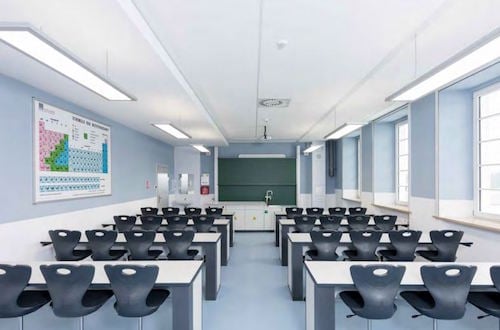
© Regiolux - HCL lighting solutions for schools
5. Private sector
Human Centric Lighting can also promote well-being in the home and counteract the dreaded winter depression. However, complete solutions are not yet offered. However, there are already a large number of modern biodynamic lamps, light therapy devices and gadgets such as the light alarm clock, which imitates the sunrise.
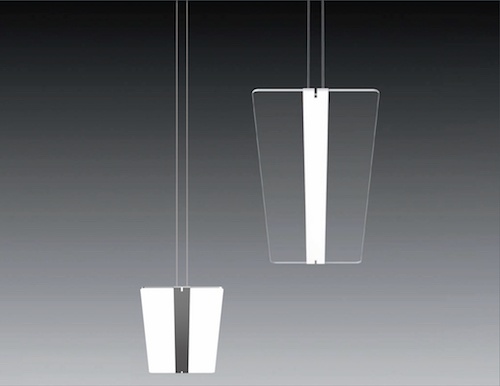
© Modern biodynamic luminaire from RZB
Conclusion: Human Centric Lighting: Biodynamic Lighting Systems in Trend
Most people spend most of their time indoors. The discovery of the third receptor in the eye led to the development of innovative lighting solutions that decisively improve people's performance and quality of life by taking into account the biological effectiveness of light. Human Centric Lighting should therefore be a central component of modern lighting concepts and be increasingly used in the future.











